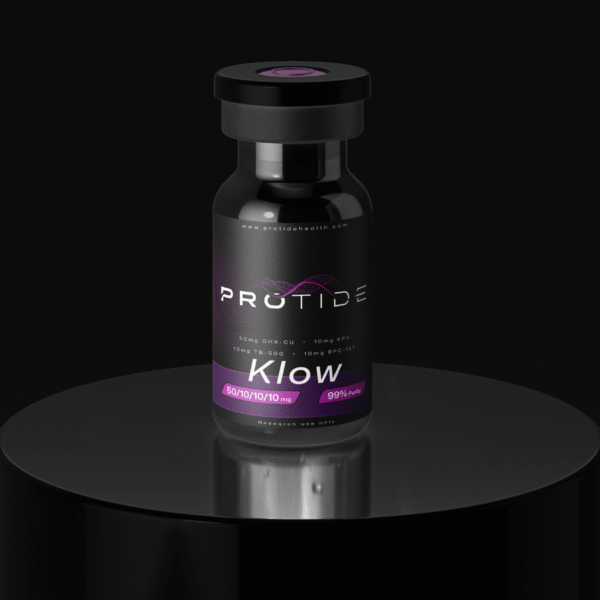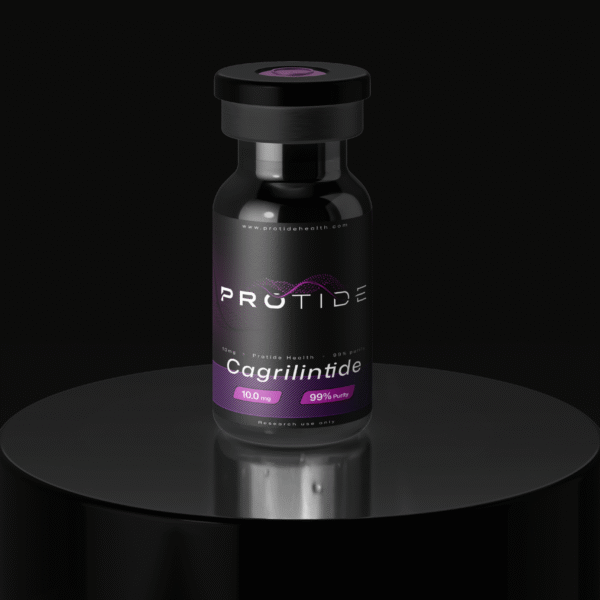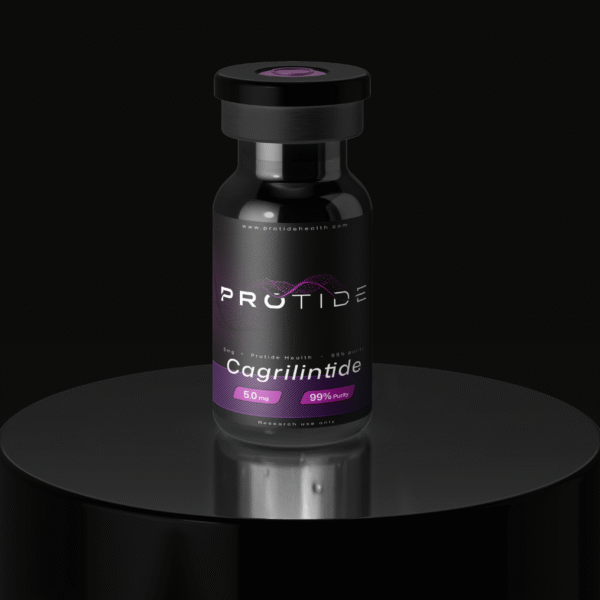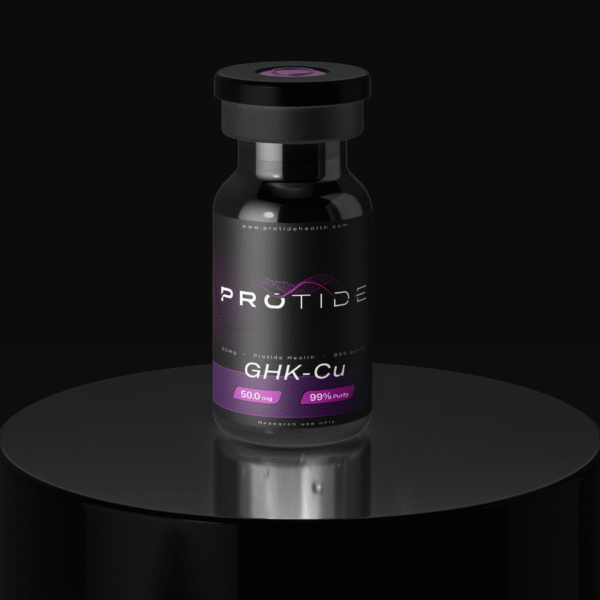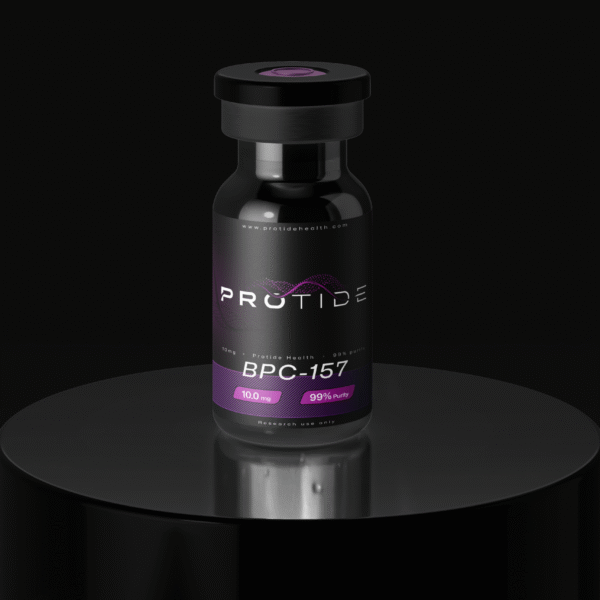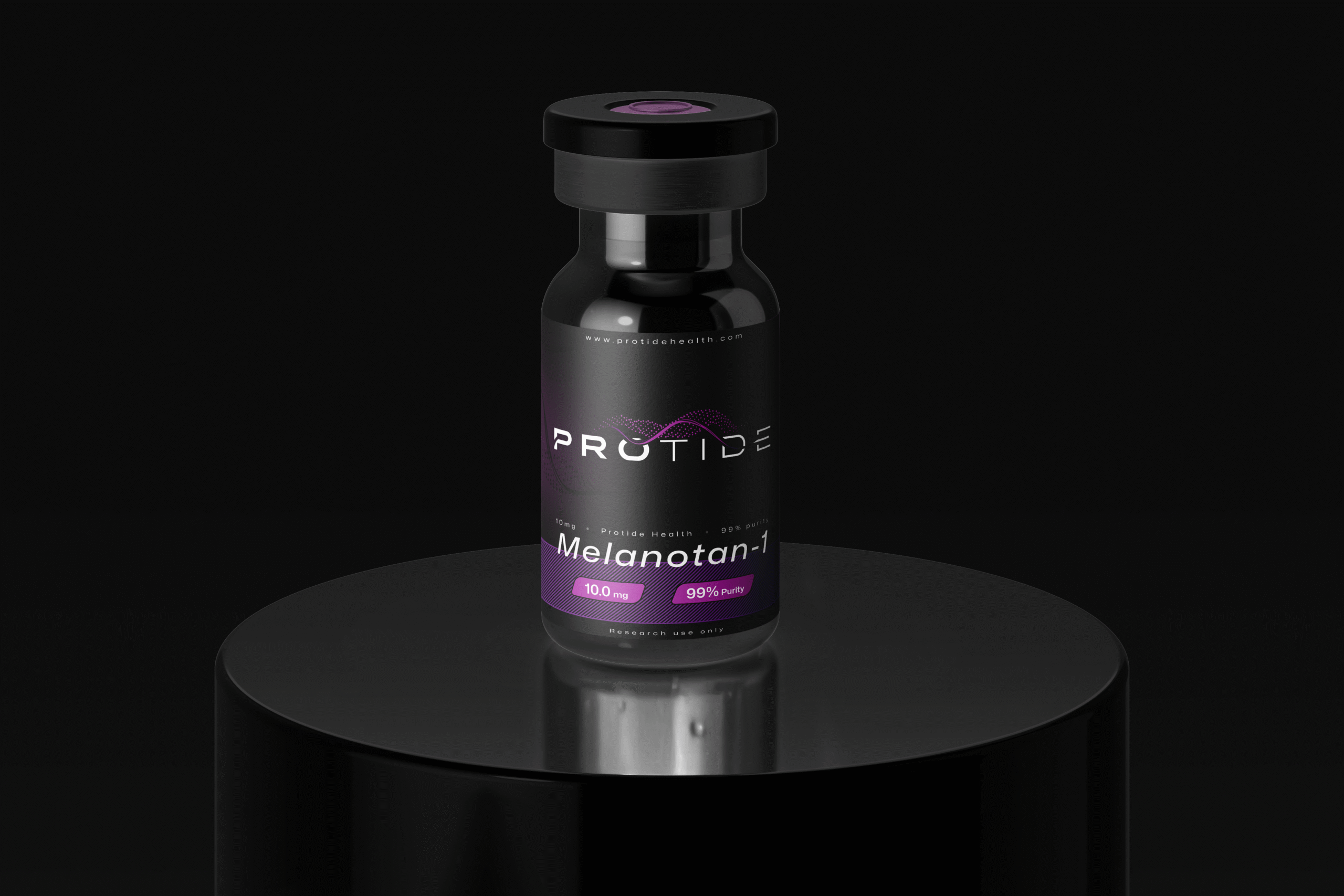
Melanotan-1 10mg
Melanotan-1, Designed to mimic the endogenous hormone’s effects on melanocortin receptors, this peptide offers valuable insights into skin pigmentation, UV response, and related physiological processes.
Description
Overview of Melanotan-1: A Peptide for Melanogenesis Research
Melanotan-1, also known as afamelanotide or [Nle4, D-Phe7]-α-MSH, is a 13-amino-acid synthetic peptide (Ac-Ser-Tyr-Ser-Nle-Glu-His-D-Phe-Arg-Trp-Gly-Lys-Pro-Val-NH2) with a molecular weight of approximately 1646.8 Da. Structurally modified from α-MSH with norleucine (Nle) at position 4 and D-phenylalanine (D-Phe) at position 7, it exhibits enhanced stability and receptor affinity PMC, Melanotan-1 Pharmacology. Synthesized for research purposes, Melanotan-1 is typically administered via subcutaneous injection or implant in preclinical models, with a half-life of about 0.7–1.5 hours, requiring precise dosing protocols PMC, Melanotan-1 Pharmacokinetics.
Investigated primarily for its melanogenic effects, Melanotan-1 binds to melanocortin-1 receptors (MC1R) on melanocytes, promoting eumelanin production and UV protection. Research focuses on its applications in skin pigmentation disorders, photoprotection, and UV-induced damage, making it a critical tool for dermatological studies PMC, Melanotan-1 Melanogenesis. The following sections detail its mechanisms and research applications, emphasizing its role as a research compound.
Mechanism of Action: Melanogenesis and Photoprotection Pathways
Melanotan-1 exerts its effects by selectively activating MC1R, triggering intracellular signaling cascades that regulate melanin synthesis and cellular responses to UV exposure. Its mechanisms have been characterized in preclinical models, with clinical data providing additional context PMC, Melanotan-1 Mechanism.
MC1R Activation: Melanotan-1 binds MC1R with high affinity, increasing cyclic AMP (cAMP) levels by 3–5-fold in melanocyte cultures, activating microphthalmia-associated transcription factor (MITF) to upregulate tyrosinase and eumelanin synthesis PMC, Melanotan-1 Melanogenesis.
Eumelanin Production: In vitro studies show a 20–30% increase in eumelanin content in human melanocytes after 48 hours of exposure to 10 nM Melanotan-1, enhancing skin pigmentation PMC, Melanotan-1 Pigmentation.
Photoprotective Effects: Melanotan-1 reduces UV-induced DNA damage by 15–25% in keratinocyte models, promoting nucleotide excision repair via p53 activation and decreasing thymine dimer formation PMC, Melanotan-1 Photoprotection.
Pharmacokinetics: In animal models, Melanotan-1 (0.1–1 mg/kg) achieves peak plasma concentrations within 30 minutes, with rapid clearance necessitating daily or implant-based dosing for sustained effects PMC, Melanotan-1 Pharmacokinetics.
Preclinical studies in guinea pigs (0.3 mg/kg/day) demonstrated a 2–3-fold increase in skin melanin content after 14 days, while phase 3 trials for erythropoietic protoporphyria (EPP) using a 16 mg subcutaneous implant showed reduced phototoxic episodes PMC, Melanotan-1 Clinical Trials. These findings underscore Melanotan-1’s research potential.
Research Applications of Melanotan-1: Insights from Preclinical and Clinical Studies
Melanotan-1’s melanogenic and photoprotective properties make it a versatile research tool for studying pigmentation, UV response, and skin disorders. The following applications are strictly for investigational use in controlled environments, supported by peer-reviewed findings:
Skin Pigmentation and Melanogenesis
Melanotan-1 is investigated for its ability to modulate skin pigmentation:
Increases eumelanin production by 20–30% in MC1R-expressing melanocytes, enhancing skin darkening in preclinical models PMC, Melanotan-1 Pigmentation.
Induces uniform tanning in albino guinea pigs, with 2-fold higher melanin density after 10 days of 0.3 mg/kg/day dosing PMC, Melanotan-1 Melanogenesis.
Used to study pigmentation disorders like vitiligo, though clinical efficacy remains under investigation PMC, Melanotan-1 Clinical Trials.
Photoprotection and UV Damage Repair
Melanotan-1’s ability to mitigate UV-induced damage is a key research focus:
Reduces thymine dimer formation by 15–25% in UV-exposed keratinocyte cultures, enhancing DNA repair via XPA upregulation PMC, Melanotan-1 Photoprotection.
Decreases UV-induced apoptosis by 20% in mouse skin models, linked to increased p53 activity PMC, Melanotan-1 Mechanism.
Explored in models of photocarcinogenesis, showing potential to lower squamous cell carcinoma risk, though human data is limited PMC, Melanotan-1 Photoprotection.
Erythropoietic Protoporphyria (EPP) Models
Melanotan-1 is studied in EPP research due to its photoprotective effects:
Reduces phototoxic episodes by 50% in EPP mouse models treated with 0.3 mg/kg/day, increasing pain-free sun exposure PMC, Melanotan-1 Clinical Trials.
Phase 3 trials using a 16 mg subcutaneous implant every 60 days showed a 30% increase in sun exposure tolerance in EPP patients PMC, Melanotan-1 EPP.
Serves as a model for studying MC1R-mediated photoprotection in photosensitive disorders PMC, Melanotan-1 Mechanism.
Neurological Research Potential
Emerging preclinical data suggest Melanotan-1’s influence on neuroinflammatory pathways via melanocortin receptors:
Reduces IL-1β expression by 10–15% in microglial cell cultures, potentially mitigating neuroinflammation PMC, Melanotan-1 Neuroinflammation.
No significant cognitive effects validated, with further research required to explore neurological applications PMC, Melanotan-1 Pharmacology.
These applications are confined to research settings, with only afamelanotide (Melanotan-1) approved for EPP under specific regulatory conditions.
Research Populations and Study Designs
Melanotan-1’s research applications target specific investigational populations and study designs:
Dermatology Researchers: Scientists studying melanogenesis, pigmentation disorders, or UV damage use Melanotan-1 in melanocyte cultures or rodent models to explore MC1R signaling PMC, Melanotan-1 Melanogenesis.
Photobiology Investigators: Researchers examining photoprotection or photocarcinogenesis employ Melanotan-1 in UV exposure models to study DNA repair PMC, Melanotan-1 Photoprotection.
Rare Disease Scientists: Those investigating EPP or photosensitivity disorders use Melanotan-1 to model photoprotective mechanisms PMC, Melanotan-1 EPP.
Typical study designs involve melanocyte cultures or rodent models (e.g., guinea pigs) dosed at 0.1–1 mg/kg/day for 7–14 days, measuring melanin content, DNA damage, or inflammatory markers. Human trials for EPP used a 16 mg implant every 60 days, assessing phototoxic episodes and sun exposure PMC, Melanotan-1 Clinical Trials.
Research Limitations and Considerations
Several limitations and considerations apply to Melanotan-1 research:
Limited Clinical Scope: Afamelanotide is approved only for EPP in select regions (e.g., EU, Australia); broader applications (e.g., vitiligo, tanning) lack regulatory approval, with phase 2/3 trials showing variable efficacy PMC, Melanotan-1 Clinical Trials.
Regulatory Status: Melanotan-1 is not approved by the FDA for general human use and is designated for research purposes only, except as afamelanotide for EPP PMC, Melanotan-1 Pharmacology.
Side Effect Profile: Preclinical studies report no significant toxicity at 0.1–1 mg/kg/day. Human trials noted mild nausea, fatigue, and injection site reactions in <5% of participants, with rare hyperpigmentation PMC, Melanotan-1 Pharmacokinetics.
Dosing Variability: Research doses (0.1–1 mg/kg/day in animals, 16 mg implant in humans) require precise protocols, with implants complicating dose adjustments PMC, Melanotan-1 Mechanism.
Long-Term Safety: Long-term data are limited to EPP trials, necessitating caution in extended research protocols PMC, Melanotan-1 EPP.
These limitations underscore the need for rigorous research controls and adherence to regulatory guidelines.
Conclusion: A Precise Tool for Pigmentation and Photoprotection Research
Melanotan-1, a synthetic melanocortin analog, is a robust research tool for studying melanogenesis, photoprotection, and photosensitivity disorders. Preclinical studies demonstrate a 20–30% increase in eumelanin, 15–25% reduction in UV-induced DNA damage, and significant photoprotection in EPP models, while clinical trials validate its safety and efficacy for EPP. For researchers investigating dermatological pathways, UV response, or rare photosensitive disorders, Melanotan-1 offers precise insights in controlled studies. Its investigational status, limited clinical scope, and dosing complexities restrict its use to research settings, except for approved EPP applications.
Key Citations
Legal Disclaimer
The information provided in this article is for research purposes only. Melanotan-1 is not approved by the U.S. Food and Drug Administration (FDA) for human consumption or therapeutic use, except as afamelanotide for erythropoietic protoporphyria (EPP) under specific regulatory approvals. It is intended solely for investigational use in controlled laboratory settings by qualified researchers. Protide Health does not endorse or promote the use of Melanotan-1 in humans or animals outside of approved research protocols or EPP treatment under medical supervision. Researchers must comply with all applicable local, state, and federal regulations, including obtaining necessary approvals for experimental use. Consult with regulatory authorities before initiating any research involving Melanotan-1.
Additional information
| Weight | 1 lbs |
|---|---|
| Dimensions | 1 × 1 × 1 in |

